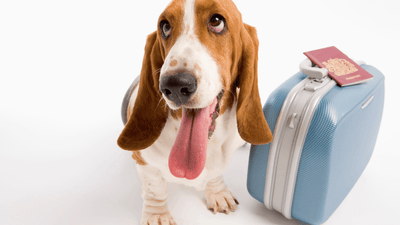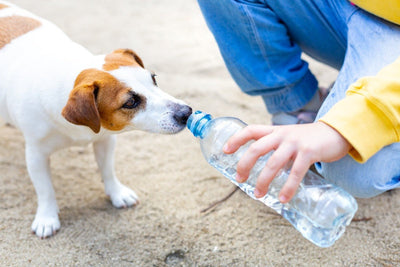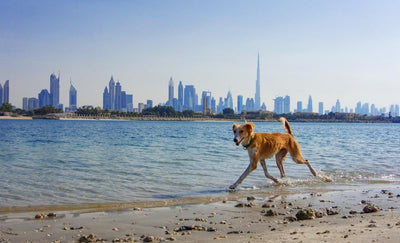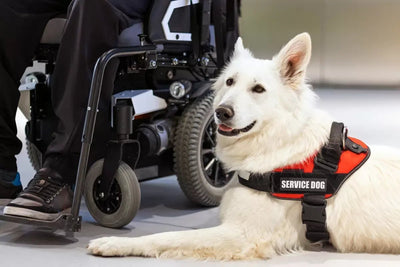 Spend AED 100 more for Free Shipping!
Spend AED 100 more for Free Shipping!
What Makes an Outstanding Grain‑Free Dog Food in the UAE: Taste, Nutrition & Allergy Relie

Introduction: Why Grain‑Free is Going Viral Among UAE Pet Owners
The last three years have seen grain‑free pet food go from niche to mainstream among UAE pet owners. Several factors are driving the trend:
-
High rate of allergies or sensitivities: Many dogs in the neighborhood develop food sensitivities or allergic reactions—itching, tummy distress, ear infections—that often are due to wheat, corn, soy, or other grain-based fillers. UAE veterinarians report that these are common culprits.
- "Humanisation" of animal care: As dog owners are considering pets like family members, they are more likely to apply close examination to what goes into their dog's food and refuse what they see as "cheap fillers" in favor of clean, natural, premium formulations.
- Climate effects: The UAE's hot, humid, and dry weather can worsen skin issues, dehydration, and general health. Grain‑free diets with better quality fats, better proteins, and low irritants are usually believed to improve skin, coat, and gut health in a warm environment. Wet foods might also enhance hydration.
All these reasons, together with better availability of grain‑free or hypoallergenic food for dogs in Dubai, Abu Dhabi, Sharjah, etc., are motivating owners to consider them more.

Ingredient Profile to Look For
When you opt to go grain‑free, not all grain‑free foods are the same. Here are the ingredient traits most critical to you:
Novel Protein Sources
- What it is: Less commonly utilized proteins in commercial dog food—venison, duck, rabbit, salmon, and lamb—rather than the ubiquitous chicken, beef, or lamb many dogs already know.
- Why it works: Allergenic dogs will react to proteins they have been constantly exposed to. New proteins reduce risk of such reactions.
Lack of Fillers & Poor‑Quality Carbohydrates
- Fillers: Cheap grain fillers (corn, wheat, soy) will contribute little more than calories and sometimes cause skin irritation in sensitive dogs.
- Grain‑free alternatives: These usually contain peas, lentils, potatoes, and sweet potatoes. These could be enhanced in some cases, but can also be problematic if they are overused or if the dog is sensitive to legumes.
Natural Preservatives & Less Artificial Additives
- Avoid artificial colouring, flavouring, or preservatives (e.g. BHT, BHA, artificial colouring) which can lead to sensitivities.
- Natural preservatives (mixed tocopherols, rosemary extract, etc.) are to be favored.
High Protein Content & Fat Quality (Omega‑3 & ‑6)
- Just because it is high in protein is no reason for a grain‑free diet to be frugal. Use meat as the primary ingredient.
- Good fats are necessary for skin and coat health, immune function, and overall well-being. Omega‑3s in fish oil (or alternate sea sources), supplemented with omega‑6s in proportion, are particularly worth their weight.
- It's especially so in the UAE: hot sun, dry air, and frequent exposure to dust/sand stress skin and water.

Ingredient Sourcing & Transparency
- Protein source: Is it pasture-raised? Wild-caught? Farmed? The more elevated the source, usually the better the nutrient matrix.
- Manufactured under good safety/hygiene procedures. Adjectives like "no cross-contamination," "limited ingredient formula," or "single source protein" are helpful.
- Regulatory compliance protocols (AAFCO, WSAVA, etc.) can assure nutritional balance.
Taste & Palatability: What UAE Pet Parents Typically Report
As UAE dog owners choose grain‑free foods, there are a few things that make an enormous difference in whether their fur babies eat it with gusto.
Preferred Flavours / Proteins
- Fish/seafood (salmon, trout, white fish) tends to do well, especially for dogs with sensitive skin (omega‑3s in addition to novel taste).
- Lamb is a popular choice as a "novel enough" protein, but relatively mild.
- Venison is more exotic, popular for owners looking for novel proteins and finicky dogs.
- Duck, rabbit, and sometimes wild boar are also used, but availability and cost can be higher.

Texture & Moisture
- Wet/canned / air‑dried foods are more appetizing, especially during hot weather, partly because the smell is stronger, and they're more moist, which aids hydration.
- Texture of kibble matters: small kibble pieces for small breeds; crunchy texture supports dental health; coatings (e.g., meat broth) add flavour.
- Mixing wet + dry on occasion is sometimes successful: introducing a little wet mix‑in can encourage finicky dogs.
Effect of Climate on Acceptance
- In very hot weather, dogs can have poor appetites. More enticing foods, moist foods, or foods with concentrated natural flavours stand better chances of acceptance.
- Also, owners prefer foods that do not spoil readily in heat, both during storage and after serving (moist foods spoil faster if left out).
Health / Allergy Considerations
Feeding grain‑free is not just an issue of avoiding grains; it's an issue of potential health benefits, risks, and transition gradualness.
Signs to Watch For
If your dog may be sensitive to its current food, watch for:
- Chronic itching, redness, and hot spots.
- Recurring ear infections.
- Poor coat condition (dullness, flaking, dryness).
- Gastrointestinal upset: vomiting, diarrhea, excessive gas, bloating.
- Behavioural signs: paw licking, face rubbing, restlessness.
- Changes in energy, weight loss, or gain.
These correlate with many reports from UAE veterinarians.
How Grain‑Free Helps (When It Does)
- Removes common allergens like wheat, corn, and soy. Helps if the allergy is grain‑based.
- If food also uses novel proteins, this will reduce exposure to protein allergens.
- Improved coat, less itching, improved digestion are often observed when switching to higher quality grain‑free or limited‑ingredient diets.
- However, grain‑free is not a magic solution; allergies can be to proteins or other additives. Legumes, potatoes etc., are added in some grain‑free diets, which themselves can cause reactions.

Veterinary Input & Transition Tips
- Speak to a veterinarian before switching diet, especially if your dog has particular known allergies. Veterinary supervision is recommended.
- Elimination diet: feed a hypoallergenic, limited‑ingredient food (grain‑free + novel protein) for a trial basis (e.g., several weeks) to see if symptoms get better.
- Switch gradually: over 7‑10 days (or more), blending old and new food to avoid digestive upset.
- Watch closely: skin, coat, stool quality, energy level. Keep a diary, if possible, of changes.
Practical Tips & Product Strengths
How to Read the Label
- Ingredient list: real meat first, then byproducts if used, but clearly listed.
- Avoid the use of generic words such as "meat" or "animal digest" without specification.
- Be wary of phrases such as "grain‑free," "single protein," and "no artificial preservatives."
- Check nutritional adequacy: terms such as "AAFCO complete & balanced" or another known standard.
- Guaranteed Analysis: protein %, fat %, fiber %, moisture. More protein and quality fats are positives.
Approximate Cost
- Grain-free premium food will be more expensive than regular grain-based dry kibble.
- Wet or air-dried types cost more per kilogram or per cal.
- Price, however, needs to be weighed against health gains (fewer vet visits, better quality of life, fewer allergy symptoms, etc.).
- In the UAE, imported premium items will have import charges; availability locally can drive price.
Where to Buy in the UAE
- Pet boutique stores in Abu Dhabi, Dubai, and Sharjah (ThePetsclub, Petzone, etc.)

- Online retailers (Amazon.ae, pet-food specialty online shops).
- A few veterinary clinics/hospitals that stock therapeutic diet brands.
- Always check freshness dates and storage; humidity/damage from heat can reduce quality.
Example Outstanding Products Standing Out in Taste & Allergy Relief
- Below are some products (non-comparative) that are good illustrations owing to ingredients, palatability, or allergy relief attributes. They are recognized for innovative proteins, grain-free, good fat profiles, etc.
- Taste of the Wild Appalachian Valley Venison & Lamb Dry Dog Food – with real venison & lamb, high protein, good for small breeds.
- ZIWI Peak Air-Dried Grain-Free Dog Food – utilizes air-drying preservative flavor; very good protein sources.
- Venison Grain-Free Limited Ingredient Formula – minimal ingredients, de-boned venison protein, appropriate for dogs with sensitive digestion or protein sensitivities.

Conclusion
Grain-free dog food can be a perfect choice for many dogs in the UAE—especially those suffering from allergies, sensitivities, or skin/coat issues. But not all grain-free dog foods are created equal. What really does count is:
- quality and freshness of protein sources,
- absence of irritants and fillers,
- healthy fats and balanced nutrition,
- palatability (flavor, moisture, texture),
- and close supervision/vet guidance when changing.
If your dog shows symptoms of allergy or distress, a trial on a well‑crafted grain‑free diet under veterinary guidance can be a game-changer. As with everything, knowledge, patience, and selecting according to your dog's individual requirements will lead to the best results.
FAQs
What is the difference between grain‑free and hypoallergenic dog food?
Grain‑free means there are no grains (like wheat, corn, rice), but it doesn’t automatically mean hypoallergenic. Hypoallergenic refers to diets that reduce or eliminate common allergens, which may include removing certain proteins, additives, or following novel protein or hydrolysed protein formulations.
Are grain‑free diets safe for all dogs?
Not necessarily. For many dogs, grains are not a problem. Grain‑free diets can be helpful if there is confirmed sensitivity to grains or other ingredients, but for others, they may be unnecessary. Also, some grain‑free foods substitute with ingredients (legumes, potatoes) that might themselves cause issues.
How long should I try a grain‑free food before expecting improvement?
Typically, an elimination diet period of 8‑12 weeks is used to assess whether symptoms (skin, GI upset) improve. Some owners/wets articles suggest improvements show in 4‑6 weeks for certain symptoms.
How to transition safely to a new dog food?
Do it gradually over about a week (or more). For example: 25% new / 75% old (days 1‑3), then 50/50, then 75/25, then fully new. Monitor for stool consistency, energy, skin/coating.
Can grain‑free diets help with itchiness and skin problems?
Yes—when those are caused or aggravated by allergens present in grain‑based ingredients or certain proteins, removing those can help. Also, good quality fats (omega‑3s) and high‑quality proteins often help improve coat, skin barrier, and reduce inflammation.
Should I consult a vet before switching to grain‑free food?
Absolutely. A vet can help determine whether your dog has allergies or sensitivities, recommend appropriate food types (novel protein, hydrolysed, etc.), ensure you don’t inadvertently cause nutritional imbalances, and monitor health (including possible risks like heart health in some cases).

 Facebook
Facebook




